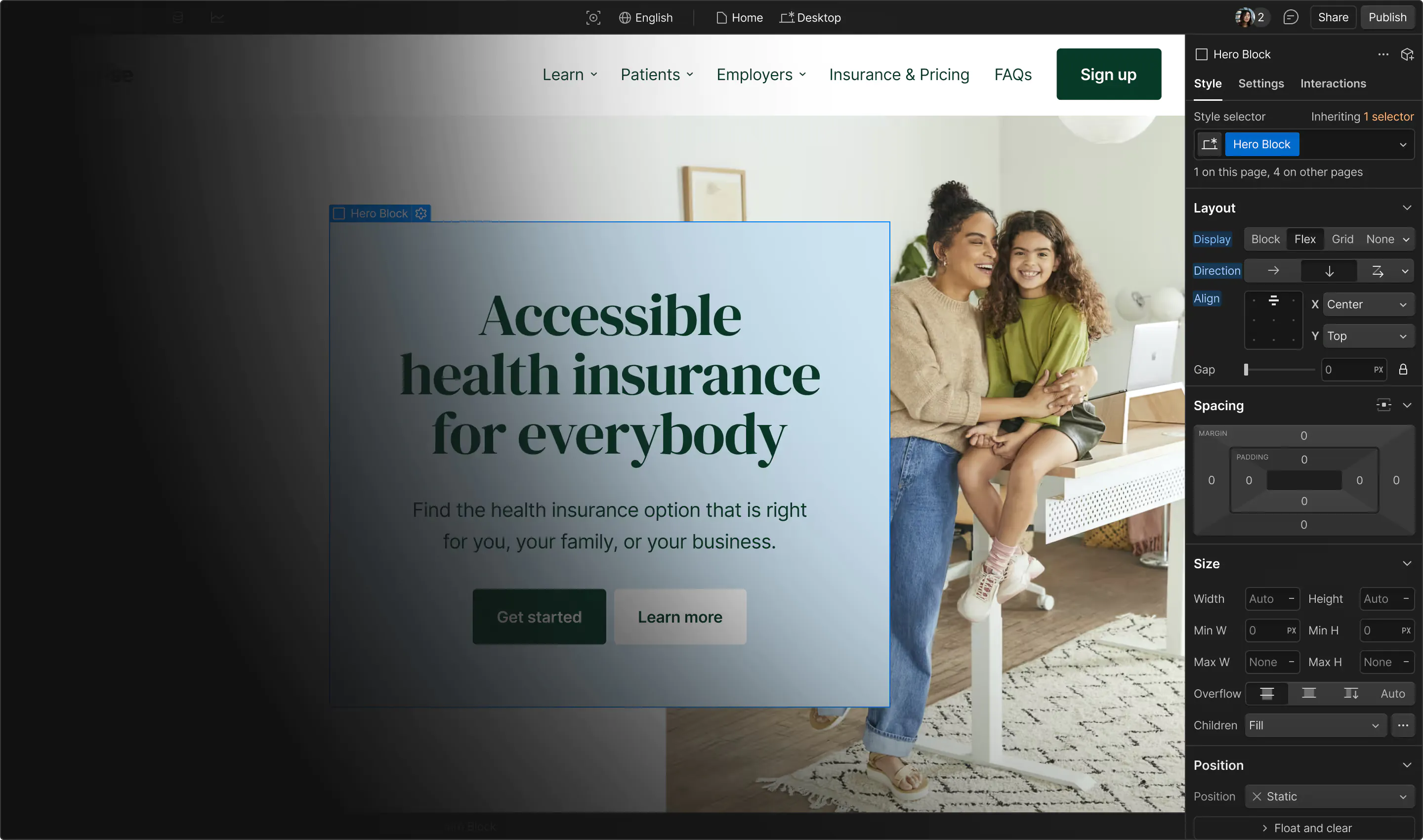On average, 93% of companies feel restricted by their content management system (CMS).
The majority of businesses agree that their webstacks are not meeting expectations, unable to accommodate even slight changes to their websites easily. While diverse in their offerings, today’s CMSs share the same underlying problems: an overreliance on technical teams, lack of marketing and design autonomy, and slow time-to-market that cuts into budgets and content optimization. Businesses need better options.
By bringing together the best parts of headless, open-source, no-code, and DXPs, Webflow’s Website Experience Platform (WXP) offers the next generation of CMS — one that prioritizes every discipline growth-minded teams need to meet their objectives.
The state of CMSs today
The web development world is moving fast, and the CMS landscape has exploded with options. When these systems first appeared, they were exactly what businesses needed. But our teams and industry have evolved dramatically since their inception.
Now businesses are stuck with tradeoffs they shouldn’t have to be making. Want something developer-friendly? Prepare for your marketing team to struggle. Need something easy for content creation? Your developers will be wasting hours stuck in the same cycles. Businesses keep adapting their workflows to fit their tools, when it should be the other way around.
Let’s explore what’s working with the CMSs in today’s market — and what’s not:
- No-code CMS: While they empower non-technical users with speed-to-market and creative freedom, they forgo developer control and scalability. As projects grow, they struggle with flexibility for custom development and content management sophistication.
- Digital experience platforms (DXP): While DXPs can support omnichannel delivery and interoperability with single-vendor simplicity, they also burden developers with code-first, lengthy implementations and ongoing support. DXPs limit both marketing agility and design creative freedom, while struggling with external martech integration. This creates financial strain through vendor lock-in and impedes rapid deployment of tests, designs, and optimizations.
- Open-source CMS: They offer collaborative flexibility through add-ons, plug-ins, and templates. However, the “plugin for everything” approach — where essential functionality may be built by a sprawling third-party ecosystem — can create challenges over time. This often leads to inefficiencies requiring developer intervention, resulting in bottlenecks, code bloat, performance issues, security risks, and high overhead costs as technology evolves.
- Headless CMS: They provide more front-end freedom and content flexibility but demand continuous developer resources for custom builds, forcing a costly reliance on engineers. Marketing teams encounter difficult interfaces that undermine the promised agility and speed-to-market.
- AI site-generation tools: They accelerate and simplify content creation and design processes through automation. However, without visual-first creative freedom for designers, these tools struggle to find balance — they slow development and are unable to ensure design integrity, streamline code iterations, and maintain accuracy over the final product.
These content management systems are hindered by their cumbersome code-first approach. As web development and design worlds continue to evolve rapidly, teams relying on such CMSs inevitably fall behind. The next generation of CMS is in demand — and it’s already available with Webflow.
The next generation of CMS: A Website Experience Platform
Businesses today face three critical challenges with CMSs: engineering dependencies that create bottlenecks and sunk costs, marketing teams unable to fully own website experiences, and slow time-to-market that prevents rapid content iteration and optimization. The industry demands a more visual, flexible, and composable approach.
Moreover, many of today’s solutions operate on a code-first infrastructure — the idea that developers can anticipate and pre-code every future marketing need. Despite promising flexibility, this approach can’t match the rapid evolution of modern website experiences or meet the dynamic needs of today’s cross-functional teams.
Webflow represents the next evolution — a Website Experience Platform that transcends existing CMS limitations. By combining marketing agility with developer flexibility, it creates the sweet spot where creative speed and technical control intersect, eliminating the compromise businesses have been forced to accept.
How Webflow addresses CMS challenges
As a Website Experience Platform, Webflow’s visual-first, composable platform provides a modern-day solution to the critical challenges of today’s CMSs:
Unblocking engineering flow
Unlike systems that create endless handoffs across developers, marketers, and designers, Webflow:
- Generates SEO-optimized HTML, CSS, and JavaScript in real-time as you interact with the visual canvas
- Offers native hosting and security infrastructure that eliminates the need for technical teams to evaluate, implement, and manage hosting solutions, freeing them from security vulnerabilities that could take down their website
- Empowers developers with MACH-certified APIs to build custom solutions that programmatically control data and content moving through Webflow and integrate your tech stack
- Empowers designers to build sophisticated websites directly, reducing engineering needs and freeing technical resources for strategic initiatives
Empowering marketing ownership
Where CMSs have typically slowed down marketers and created bottlenecks, Webflow puts them in the driver’s seat. Marketing teams can generate, modify, and optimize content independently using design-approved components and built-in AI tools, gaining complete ownership of the web experience without compromising quality. This self-sufficiency means faster campaign launches and the ability to respond instantly to market opportunities.
“With Webflow, we’ve significantly improved organic traffic, SEO, and conversions. From my perspective as CMO, that’s a huge win because our brand is reaching more people.”
- Elizabeth Walton Egan, Chief Marketing Officer at Lattice
Accelerating time-to-market
Webflow eliminates the slow iteration cycles that plague other CMSs. Our intuitive visual development tools empower teams to break free from rigid templates thanks to the ability to quickly create new layouts and design elements. This allows teams to rapidly create content, publish instantly, and leverage built-in optimization tools, so they can seamlessly test, refine, and scale their digital presence while maintaining efficient developer collaboration. In fact, Oyster achieved a 6x faster time-to-market with Webflow.
With the addition of Webflow’s AI Optimize, businesses can leverage dynamic personalization to experiment, test, and learn faster — creating a continuous improvement cycle that some CMSs cannot match.
This integrated approach doesn’t just solve the challenges of existing CMSs — it transforms them into strategic advantages, enabling businesses to deploy high-performing website experiences faster, more cost-effectively, and more personalized than ever before.
Setting the stage for new web experiences
Webflow was designed to empower every role in the website creation process, regardless of their technical background. Designers get powerful visual tools that preserve their creative vision. Marketers gain the independence to create and optimize without bottlenecks. Developers retain the flexibility to customize code when innovation demands it.
This inclusive approach means no one needs to compromise their workflow or capabilities, creating an environment where cross-functional teams can finally collaborate at their full potential. Learn more about how to supercharge your website with a scalable CMS like Webflow.


















































